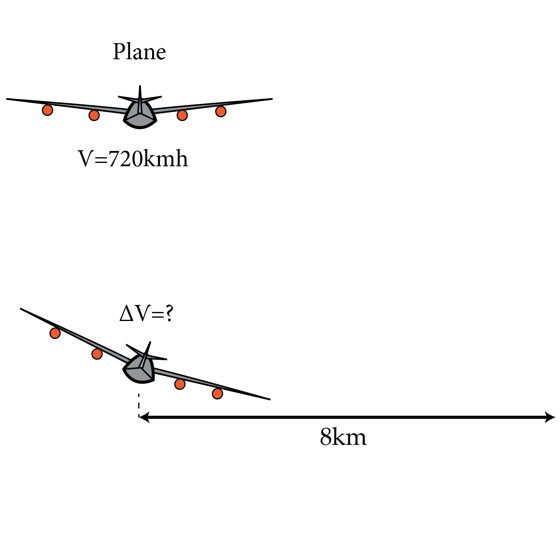A simple flying maneuver
A plane flies horizontally at constant ground speed v = 7 2 0 km/h . The pilot is informed by an air traffic controller that he must immediately change his direction of flight while keeping the same altitude. The pilot performs a turning maneuver by rolling the plane to a banked position. Then she increases the airspeed in Δ v to keep the plane at constant altitude. As a result, the plane describes an arc of radius R = 8 km . Find the increase in airspeed Δ v in km/h . Assume that the lift force is proportional to the square of the speed and that it is always perpendicular to the plane of the wings.

Details and assumptions
g = 9 . 8 m / s 2
The answer is 56.4.
This section requires Javascript.
You are seeing this because something didn't load right. We suggest you, (a) try
refreshing the page, (b) enabling javascript if it is disabled on your browser and,
finally, (c)
loading the
non-javascript version of this page
. We're sorry about the hassle.
2 solutions
The relevant forces acting on the aircraft are the lift F L and the weight F g = m g . There are two more forces acting on the plane: thrust and drag. However, they need not be taken into account as they cancel out. When the plane is flying horizontally at v 0 = 7 2 0 k m / h we have that F g = m g = F L = k v 0 2 → k = v 0 2 m g . When the plane banks, the airspeed must be increased in order to keep the same vertical component of the lift force. From a free body diagram we see that F L 2 = F g 2 + F n e t 2 Here F L = k v 2 while F n e t is the net force acting on the plane. Clearly, the acceleration of the plane during its turn is centripetal. From Newton's second Law we have that F n e t = R m v 2 . Combining the above equations we find the velocity of the plane during the turn. v = ( 1 − g 2 R 2 v 0 4 ) 1 / 4 v 0 = 7 7 6 . 4 km/h → Δ v = 5 6 . 4 km/h .
Suppose that the original lift force was F 0 , and that the new lift force (perpendicular to the plane) is F l . Also, let the angle above horizontal that the wings are at be θ . Note that the new vertical lift force is F l cos θ . Because the new and original vertical lift force must be equal, we have
F 0 = F l cos θ .
Let the new velocity be v f = v + Δ v . Because the lift force is proportional to the square of the velocity, we have
7 2 0 2 F 0 = F l v f 2
7 2 0 2 F l cos θ = F l v f 2
v f 2 × cos θ = 7 2 0 2 .
Also, since the plane if flying a banked curve, we have the formula:
tan θ = r g v 2 = 8 g v 2
Unfortunately, we must convert 9 . 8 m/sec 2 into kilometers per hour. There are 1 0 0 0 meters in a kilometer and ( 3 6 0 0 ) 2 square seconds in a square hour, so we multiply by 1 0 0 0 3 6 0 0 2 and get
g = 1 2 7 0 0 8 kilometers per square hour.
Therefore,
θ = tan − 1 ( 8 ( 1 2 7 0 0 8 ) v 2 )
Plugging this into the earlier equation gives us
v f 2 × cos tan − 1 ( 8 ( 1 2 7 0 0 8 ) v 2 ) = 7 2 0 2 .
Solving this equation for v f gives us v f = 7 7 6 . 3 7 . Therefore,
Δ v = v f − v = 5 6 . 4